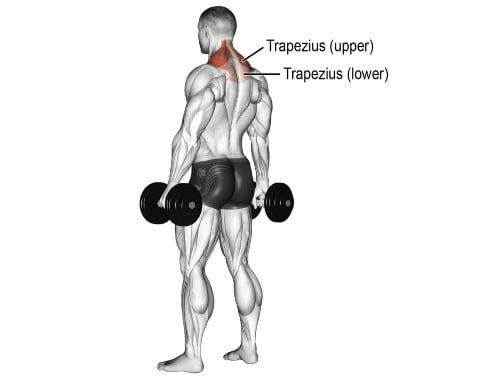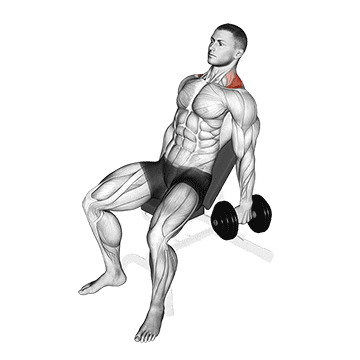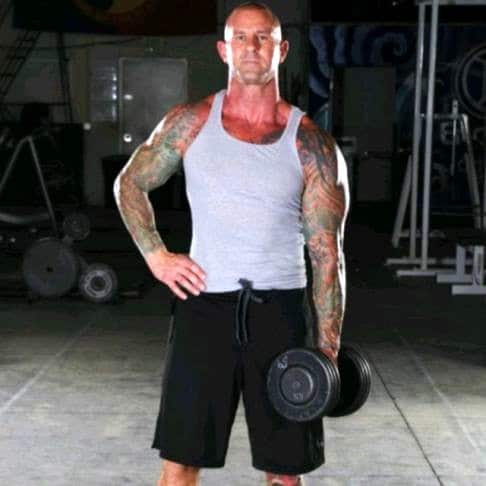Dumbbell shrugs, also known as dumbbell shoulder shrugs, are isolation exercises that target the upper trapezius muscle.
The shrug is a frontal plane movement that involves scapular elevation (raising the shoulder girdle directly toward the ears).
Remember, your traps can handle significant loads due to their mechanical advantage in this movement pattern. Once your form is impeccable, don’t be afraid to challenge yourself with appropriate weight progression.
You can do this exercise with a medium- to heavy-weight dumbbell to make your traps thicker.
It is a simple yet effective exercise that strengthens the shoulders, upper back, and neck muscles. They are suitable for both beginners and pros.

- Dumbbell Shrug Muscles Worked
- How To Do Dumbbell Shrug
- Form and Tips
- 3 Best Dumbbell Shrug Variations
- 1. Incline Dumbbell Shrug
- 2. Seated Dumbbell Shrug
- 3. Single Arm Dumbbell Shrug
- Add Dumbbell Shrug Into Your Workout Routine
- I. During the Shoulder Workout
- II. During Pull Workout Split
- III. During Upper Body Workout
- References
Dumbbell Shrug Muscles Worked
- Primary Muscle: Upper Trapezius
- Secondary Muscles: Levator scapulae, Rhomboids, Middle Trapezius, Rotator cuff muscles and Forearms (grip strength)
The trapezius is a diamond-shaped muscle extending from the base of your skull to the middle of your back and across your shoulders. It’s divided into three regions:
- Upper traps: Responsible for shoulder elevation (the primary movement in shrugs)
- Middle traps: Scapular retraction
- Lower traps: Scapular depression and downward rotation

How To Do Dumbbell Shrug
- Stand tall with your feet shoulder-width apart. Keep a slight bend in your knees – avoid locking them out.
- Hold a dumbbell in each hand with a neutral grip (palms facing your sides). Let the dumbbells hang naturally at arm’s length beside your torso.
- Maintain a straight back, chest up, and shoulders slightly back. Your gaze should be neutral, looking straight ahead or slightly down. Avoid craning your neck forward.
- Keep your arms straight (do NOT bend your elbows like a curl), and consciously elevate your shoulders straight up towards your ears.
- Focus on using only your upper trap muscles to drive the movement. Imagine that a string pulls the top of your shoulders straight ups.
- At the top of the movement, squeeze your traps hard when your shoulders are as high as they can go.
- Slowly and controlled, lower the dumbbells back down to the starting position.
Form and Tips
- Keep your arms straight (a slight bend in the elbows is okay). Focus on lifting your shoulders straight up towards your ears.
- Don’t hold your breath while performing the exercise.
- Engage your core and keep your back straight throughout the exercise.
- Don’t let your chin jut forward as you reach the top of the shrug. Forward head posture during shrugs can compress cervical vertebrae. Maintain a neutral neck position.
- Adding a pause at the top of the movement can help to enhance the mind-muscle connection.
- Limit momentum and excessive jerking or bouncing of the weight.
- People often turn this into a “roll” rather than a lift. Rolling adds shoulder impingement risk and doesn’t efficiently target the traps. The shrug should be a vertical movement—up and down.

3 Best Dumbbell Shrug Variations
Once you’ve practised the standard dumbbell shrug, consider trying these variations:
1. Incline Dumbbell Shrug
While the standing shrug is primarily an elevation movement targeting the upper traps against gravity’s downward pull, lying face-down on an incline bench places more stress on the Middle Traps (responsible for retraction – pulling shoulder blades together).
This position reduces momentum and stabilises the spine, allowing a more focused contraction of the trapezius muscles.
When done correctly, this version is harder than standing shrugs, because you can’t “cheat” the movement with leg drive or back sway.

2. Seated Dumbbell Shrug
If you want to focus on your trap muscles and not your core, try this variation of the dumbbell shrug exercise while sitting.
When performed correctly, this variation locks your lower body in place, preventing leg drive and helping you focus solely on scapular elevation—the true function of the upper traps.
I often program seated shrugs for clients whose lower backs fatigue before their traps do during heavy standing shrugs.

3. Single Arm Dumbbell Shrug
The single-arm dumbbell shrug is an elite-level tool for correcting muscular imbalances or deepening your mind-muscle connection with your traps.
This exercise offers more than trap development—it improves unilateral strength and core stability.

Add Dumbbell Shrug Into Your Workout Routine
You can perform shrug exercises as part of an upper body or during a push-pull leg workout Split.
Dumbbell shrugs can be included in your shoulder workout routine alongside other exercises such as overhead press, lateral raise, and front raise.
A good starting point is to perform 3–4 sets of 8–12 reps.
I. During the Shoulder Workout
| S.NO | Exercise | Sets | Reps |
|---|---|---|---|
| 1 | Seated Dumbbell Shoulder Press | 3-4 | 8-12 |
| 2 | Standing Dumbbell Lateral Raise | 3-4 | 10-15 |
| 3 | Dumbbell Shrug | 3 | 10-12 |
| 4 | Front Plate Raise | 3 | 12-15 |
| 5 | Upright Row | 3 | 10-12 |
II. During Pull Workout Split
| S.NO | Exercise | Sets | Reps |
|---|---|---|---|
| 1 | Pull-Ups | 3-4 | 8-10 |
| 2 | Bent Over Barbell Rows | 3-4 | 8-10 |
| 3 | Dumbbell Shrug | 3 | 10-12 |
| 4 | Bicep Curls (with dumbbells or barbell) | 3 | 12-15 |
| 5 | Hammer Curls | 3 | 10-12 |
| 6 | Dumbbell Shrug | 3 | 12-15 |
III. During Upper Body Workout
| S.NO | Exercise | Sets | Reps |
|---|---|---|---|
| 1 | Bench Press (with barbell or dumbbells) | 3-4 | 8-10 |
| 2 | Seated Dumbbell Shoulder Press | 3-4 | 8-12 |
| 3 | Dumbbell Shrug | 3-4 | 10-12 |
| 4 | Lat Pulldowns (with machine or bar) | 3-4 | 10-12 |
| 5 | Cable Tricep Pushdowns | 3 | 12-15 |
| 6 | Bicep Curls (with dumbbells or barbell) | 3 | 12-15 |
Thanks for reading!
References
- Pizzari T, Wickham J, Balster S, Ganderton C, Watson L. Modifying a shrug exercise can facilitate the upward rotator muscles of the scapula. Clin Biomech (Bristol, Avon). 2014 Feb;29(2):201-5. doi: 10.1016/j.clinbiomech.2013.11.011. Epub 2013 Nov 26. PMID: 24342452.
- Choi WJ, Cynn HS, Lee CH, Jeon HS, Lee JH, Jeong HJ, Yoon TL. Shrug exercises combined with shoulder abduction improve scapular upward rotator activity and scapular alignment in subjects with scapular downward rotation impairment. J Electromyogr Kinesiol. 2015 Apr;25(2):363-70. doi: 10.1016/j.jelekin.2014.12.001. Epub 2014 Dec 13. PMID: 25553964.
- Lee JH, Cynn HS, Choi WJ, Jeong HJ, Yoon TL. Various shrug exercises can change scapular kinematics and scapular rotator muscle activities in subjects with scapular downward rotation syndrome. Hum Mov Sci. 2016 Feb;45:119-29. doi: 10.1016/j.humov.2015.11.016. Epub 2015 Nov 25. PMID: 26625348.

Manish is a NASM-certified fitness and nutrition coach with over 10 years of experience in weight lifting and fat loss fitness coaching. He specializes in gym-based training and has a lot of knowledge about exercise, lifting technique, biomechanics, and more.
Through “Fit Life Regime,” he generously shares the insights he’s gained over a decade in the field. His goal is to equip others with the knowledge to start their own fitness journey.
